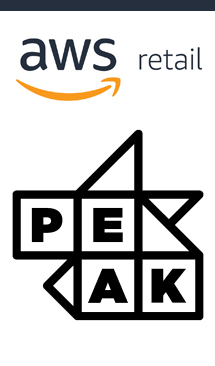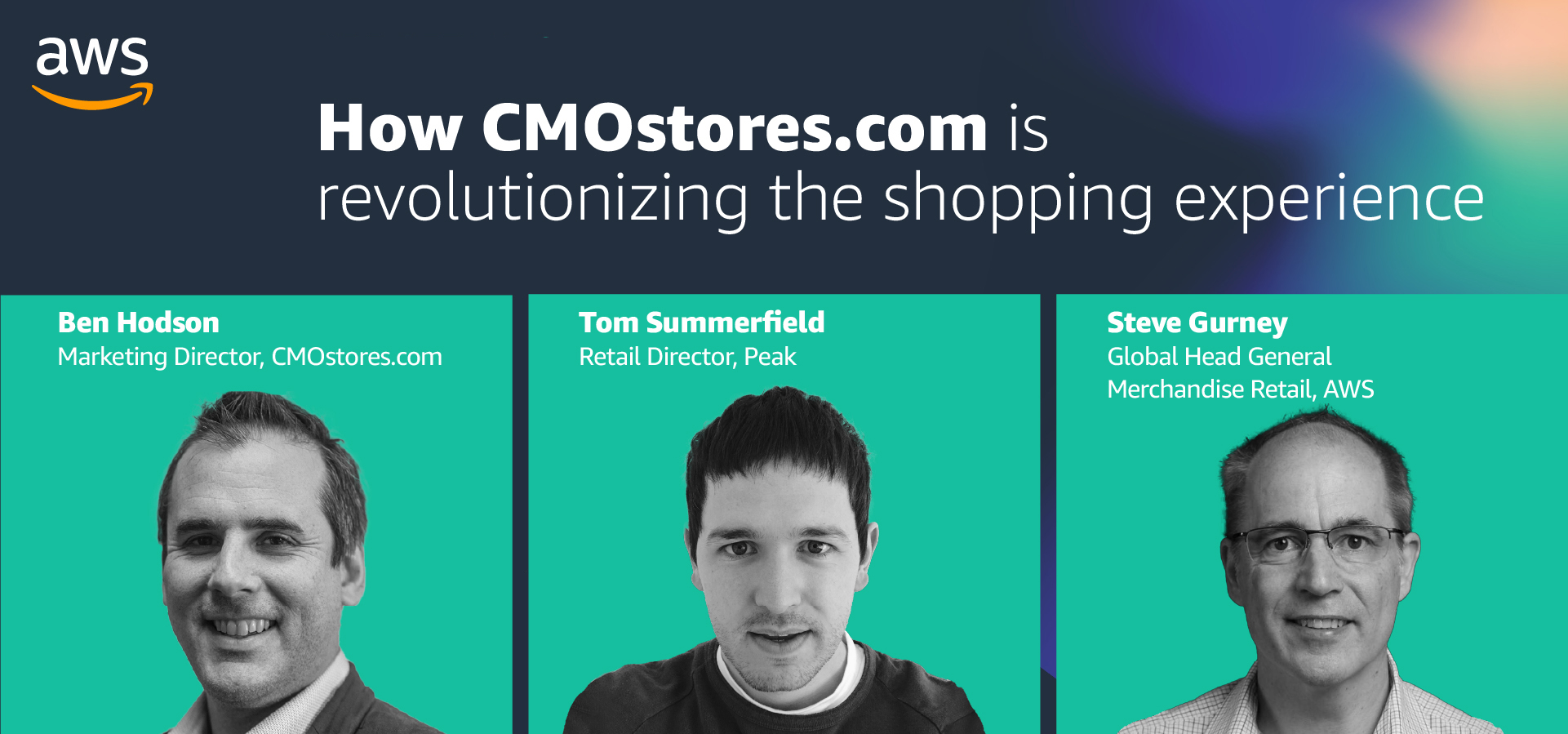AWS for Industries
Retail Partner Conversations: How Innovative Retailers Are Embracing AI-based Decision Making with Peak
 As retailers around the world are experiencing unprecedented disruption, industry leaders are demonstrating resilience, tenacity, and a capacity for innovation. We’ve embarked on a series of conversations with executives from AWS Retail Competency Partners to showcase their leadership and innovation in challenging times.
As retailers around the world are experiencing unprecedented disruption, industry leaders are demonstrating resilience, tenacity, and a capacity for innovation. We’ve embarked on a series of conversations with executives from AWS Retail Competency Partners to showcase their leadership and innovation in challenging times.
In the latest installment of our AWS Retail Competency Partner Conversations blog series, we chatted with Tom Summerfield, Retail Director at Peak, a decision intelligence company. Peak’s CODI solution is a SaaS platform that applies advanced AI workflows to enterprise data to help companies make better decisions across the entire business—from shopper acquisition to supply chain and everything in between. Tom talks about harnessing the power of data to optimize retail operations, including demand forecasting and inventory management, and create winners, even in turbulent times.
AWS: Help our readers understand your vantage point. What are Peak’s key segments in the retail industry, and with what type of retail executives do you interact?
Tom: Peak is an AWS Advanced Partner with AWS Retail and Machine Learning Competencies. We help businesses do great things with data in industries like retail, consumer packaged goods (CPG), and manufacturing. We provide our customers with technologies and skills to compete and win in the Decision Intelligence era.
Our decision intelligence offering, powered by AWS, helps leading retailers, including Nike, boohoo, and Superdry, apply AI to data across their enterprise so they always make data-driven decisions. It’s the practice of using AI to enhance decisions that helps teams sift through complex data to make decisions faster, more consistently, and more accurately than ever before.
Our system, CODI, combines multiple sources of data from across a retail business, enriches the data with AI, and puts this new, predictive data to work—generating sales, improving demand forecast accuracy, and optimizing supply chains.
AWS: Retail companies are managing through a period of unprecedented disruption. What have been the biggest challenges facing your retail customers?
Tom: The past 12 to 18 months have been very turbulent for retailers, and we’ve seen many household names disappear from the high street because of the pandemic. While other retailers have managed to get through this difficult period, it’s not been an easy ride—particularly in demand forecasting and inventory management.
With the ecommerce boom, shoppers want convenience at every touchpoint. Their expectations have never been higher, but at the same time, shopper behavior has become much harder to predict. Retailers face a massive, multipronged challenge: How can they accurately predict their shoppers’ next move, and at the same time, how can they nail forecast accuracy to avoid out-of-stocks, keep shoppers happy, and never miss a sale?
AWS: How do you see retailers adjusting their operating environments to current market dynamics and changing shopper expectations?
Tom: Product availability is the new battleground, and that means retailers need to use data from across the organization to its full potential to connect different areas of the business to ensure products are always available. This is a business imperative, especially as we see shops reopen and as ecommerce continues to boom.
By connecting disparate datasets and utilizing smart technologies, retailers can make better predictions and decisions about stock levels, product allocations, and replenishment. At Peak, we’re seeing firsthand the difference between retailers who operate in silos and those who are connecting their demand levers to other areas of the business—from marketing to the supply chain.
This idea of connected commerce means retailers link different functions to streamline the typical disconnect between departments, like sales and supply chain, to power a slick operation with accurate demand forecasting at its core.
AWS: The retail industry is incredibly resilient. As you look forward, what role do you think technology and the cloud will play for retailers? How do you see technology enhancing the shopper experience and improving operational efficiencies?
Tom: Already, retailers have been realizing the benefits of adding technologies like AI to their operations, and the pandemic accelerated this trend. Advanced technologies are no longer a nice-to-have for retailers—it’s table stakes to differentiate the winners and losers.
Technologies, like Peak’s Customer Intelligence solution and Amazon Personalize, are helping retailers get closer to shoppers and guiding marketing decisions with data. On the other side, Demand Intelligence and Amazon Forecast are helping businesses make smarter decisions about stock management.
Placing AI at the heart of a retail business is incredibly powerful and transformative, driving tangible commercial outcomes, efficiency gains, and optimal shopper experiences.
AWS: With the current disruptions in the retail industry, how is your company innovating to help your retail customers?
Tom: We work with some of the most forward-thinking retailers who’ve already embraced AI and put it at the center of their decisioning. They’re taking a data-first approach, so they emerge from this transitional period in as strong a position as possible.
We helped the trendsetting UK fashion brand PrettyLittleThing acquire new ideal shoppers as it expands into the US amidst the pandemic. Footasylum, another leading UK fashion retailer, has enjoyed amazing results with Peak’s help, including a 28% uplift in email revenues thanks to hyperpersonalized marketing communications and an outstanding 8,400% return on social media ad spend through AI-powered advertising.
Peak works with retailers in many other industries too. CMOStores.com, an up-and-coming online building materials company, used our decision intelligence solution to recommend product purchases, leading to a 5% revenue increase.
AWS: There’s so much talk now that the shopping experience has changed, and there’s a “new normal” going forward. What does this “new normal” look like to you, and how do you think the retail experience will look three years from now?
Tom: One trend I expect to continue is the use of stores for online fulfillment. Retailers have been using stores differently to meet the needs of omnichannel shoppers. At some point in the future, this will become the endgame for all physical retail stores. In fact, UK retailer Next is a great example of this approach and announced in its annual report its commitment to keep “loss-making stores” open to support delivery-to-store and ship-from-store processes.
This aspect of retail is perfectly primed for AI optimization. Imagine having an intelligent AI function plugged into your ERP system to guide inventory across your store footprint, ensuring no shopper is ever disappointed. This is possible with an agile stock inventory system that provides an intelligent view of shopper data for more accurate forecasts, predicting what your shoppers will do next—before asking them.
AWS: What excites you about the future of retail?
Tom: We have been witnessing a direct correlation between a retailer’s level of investment in AI and whether they are winning in today’s retail environment. And the future is incredibly exciting for the winning retailers because a well-executed, connected commerce model drives endless possibilities.
Here are a few examples:
- When an item’s availability is flagged as a potential supply chain challenge, winning retailers factor this into their recommendation engine’s algorithm to suggest alternate products to shoppers that are readily available in the supply chain within the required delivery window.
- Conversely, when faced with slow-moving SKUs, winning retailers leverage clever, personalized digital marketing to guide shoppers to these products for purchase.
There are big opportunities for retailers in the new normal, despite increased competition and a challenging market. By accurately predicting demand and linking this data to other parts of your business—connecting the dots across the entire retail operation—savvy retailers can deliver the ultimate convenience to shoppers.
AWS: Thanks for chatting with us, Tom. We appreciate your insights and expertise.
If you have questions for Tom, Peak, or AWS, leave a comment on this blog. If you’d like to see Peak in action, watch this webinar featuring CMOStores.com.
